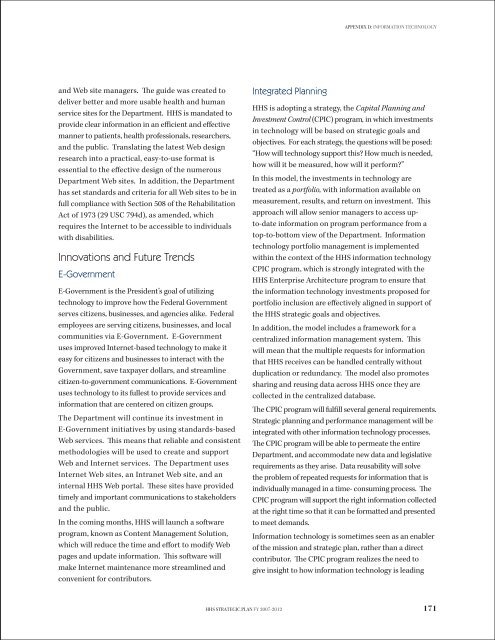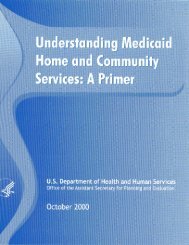STRATEGIC PLAN - ASPE - U.S. Department of Health and Human ...
STRATEGIC PLAN - ASPE - U.S. Department of Health and Human ...
STRATEGIC PLAN - ASPE - U.S. Department of Health and Human ...
Create successful ePaper yourself
Turn your PDF publications into a flip-book with our unique Google optimized e-Paper software.
Appendix d: information technology<strong>and</strong> Web site managers. The guide was created todeliver better <strong>and</strong> more usable health <strong>and</strong> humanservice sites for the <strong>Department</strong>. HHS is m<strong>and</strong>ated toprovide clear information in an efficient <strong>and</strong> effectivemanner to patients, health pr<strong>of</strong>essionals, researchers,<strong>and</strong> the public. Translating the latest Web designresearch into a practical, easy-to-use format isessential to the effective design <strong>of</strong> the numerous<strong>Department</strong> Web sites. In addition, the <strong>Department</strong>has set st<strong>and</strong>ards <strong>and</strong> criteria for all Web sites to be infull compliance with Section 508 <strong>of</strong> the RehabilitationAct <strong>of</strong> 1973 (29 USC 794d), as amended, whichrequires the Internet to be accessible to individualswith disabilities.Innovations <strong>and</strong> Future TrendsE-GovernmentE-Government is the President’s goal <strong>of</strong> utilizingtechnology to improve how the Federal Governmentserves citizens, businesses, <strong>and</strong> agencies alike. Federalemployees are serving citizens, businesses, <strong>and</strong> localcommunities via E-Government. E-Governmentuses improved Internet-based technology to make iteasy for citizens <strong>and</strong> businesses to interact with theGovernment, save taxpayer dollars, <strong>and</strong> streamlinecitizen-to-government communications. E-Governmentuses technology to its fullest to provide services <strong>and</strong>information that are centered on citizen groups.The <strong>Department</strong> will continue its investment inE-Government initiatives by using st<strong>and</strong>ards-basedWeb services. This means that reliable <strong>and</strong> consistentmethodologies will be used to create <strong>and</strong> supportWeb <strong>and</strong> Internet services. The <strong>Department</strong> usesInternet Web sites, an Intranet Web site, <strong>and</strong> aninternal HHS Web portal. These sites have providedtimely <strong>and</strong> important communications to stakeholders<strong>and</strong> the public.In the coming months, HHS will launch a s<strong>of</strong>twareprogram, known as Content Management Solution,which will reduce the time <strong>and</strong> effort to modify Webpages <strong>and</strong> update information. This s<strong>of</strong>tware willmake Internet maintenance more streamlined <strong>and</strong>convenient for contributors.Integrated PlanningHHS is adopting a strategy, the Capital Planning <strong>and</strong>Investment Control (CPIC) program, in which investmentsin technology will be based on strategic goals <strong>and</strong>objectives. For each strategy, the questions will be posed:“How will technology support this? How much is needed,how will it be measured, how will it perform?”In this model, the investments in technology aretreated as a portfolio, with information available onmeasurement, results, <strong>and</strong> return on investment. Thisapproach will allow senior managers to access upto-dateinformation on program performance from atop-to-bottom view <strong>of</strong> the <strong>Department</strong>. Informationtechnology portfolio management is implementedwithin the context <strong>of</strong> the HHS information technologyCPIC program, which is strongly integrated with theHHS Enterprise Architecture program to ensure thatthe information technology investments proposed forportfolio inclusion are effectively aligned in support <strong>of</strong>the HHS strategic goals <strong>and</strong> objectives.In addition, the model includes a framework for acentralized information management system. Thiswill mean that the multiple requests for informationthat HHS receives can be h<strong>and</strong>led centrally withoutduplication or redundancy. The model also promotessharing <strong>and</strong> reusing data across HHS once they arecollected in the centralized database.The CPIC program will fulfill several general requirements.Strategic planning <strong>and</strong> performance management will beintegrated with other information technology processes.The CPIC program will be able to permeate the entire<strong>Department</strong>, <strong>and</strong> accommodate new data <strong>and</strong> legislativerequirements as they arise. Data reusability will solvethe problem <strong>of</strong> repeated requests for information that isindividually managed in a time- consuming process. TheCPIC program will support the right information collectedat the right time so that it can be formatted <strong>and</strong> presentedto meet dem<strong>and</strong>s.Information technology is sometimes seen as an enabler<strong>of</strong> the mission <strong>and</strong> strategic plan, rather than a directcontributor. The CPIC program realizes the need togive insight to how information technology is leadingHHS Strategic Plan FY 2007-2012171
















